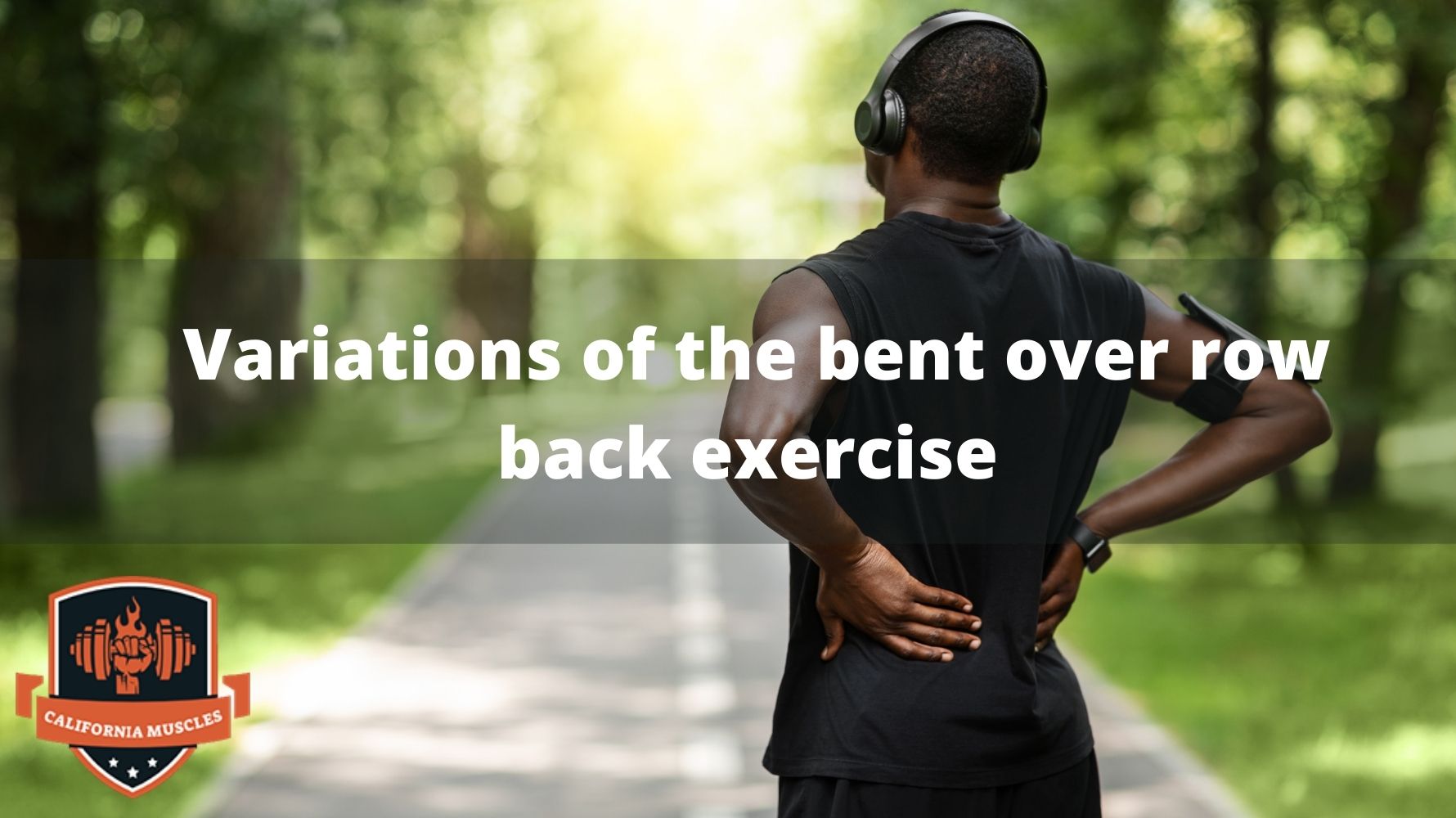The bent over row is a basic back exercise for the development of muscle strength, which is suitable even for beginners. It improves posture and develops the muscles of the back and shoulders. There are several variants of this exercise with a barbell, dumbbells, harnesses and or using simulators.
The working muscles
Pulling a barbell or dumbbells within a bent over row, is a basic exercise that works simultaneously on several muscle groups.
The primary target muscles are the middle and upper back: the trapezius and rhomboid muscles.
- The trapezoid controls the movement of the shoulder blades.
- The rhomboid muscles are responsible for the compression of the shoulder blades.
When lifting a weight with an inclined torso, these two muscles tense up and bear the main load.
The primary muscles of the arms that work when perfuming a bent over row are the biceps. The biceps controls the flexion of the arm at the elbow and tightens when lifting weight against gravity. When lowering the weight, the triceps acts as stabilizer muscles.
The bent over row works well on the shoulders and torso muscles, especially the deltoids and the widest muscle of the back. The deltoid muscles are responsible for the rounded shape of the shoulders and control the ability to move the arms backwards or turn them outward. The latissimus dorsi is responsible for the extension and rotation of the shoulders.
The secondary muscles that function in this exercise include the subacute rotator muscle of the shoulder, the large round muscle that supports the latissimus dorsi, and the large pectoral muscle that works as a stabilizer when lowering the weight.
Variations of performing the exercise
The bend over row can be performed using a barbell, one or two dumbbells.
Barbell row
Stand in front of the barbell, put your feet on the width of your hips or shoulders. Bend your legs slightly at the knees, tilt your torso forward to the floor at an angle of 45 degrees. Maintain the natural curve of the lower back.
With your palms turned to the floor, take the bar at a width slightly wider than the width of the shoulders.
As you lift the barbell, slightly spread your knees, maintaining the position of the torso. Linger as soon as the barbell is just below the knees, as this is the starting position.
Next:
- As you exhale, pull the barbell up to the lower part of the stomach. Keep your elbows tightly pressed to the body, the torso should be motionless.
- Linger at the top of the rise and tighten the back muscles.
- Inhale as you lower the barbell to the starting position just below the knees.
- Repeat the exercise.
Experiment with different grips when performing a barbell bent over row in order to work out different muscle groups or make the workout more effective.
- Instead of grabbing the neck from above, take it from below, turning your palms to the ceiling. In this case, you remove some of the load from the back and make the biceps and the latissimus dorsi work more.
- Another way is to use a wide grip twice as wide as usual. This technique makes the back work harder. A narrower grip will focus on the rhomboid muscle.
Due to the barbell row offering greater comfort to lift heavy weights, this is mainly done by those who are looking to gain large amounts of muscle mass. Due to this, many athletes use Sustanon, Equipoise and Dianabol, or Testosterone Cypionate, Nandrolone Decanoate and Anadrol. With the use of any of these combinations, an athlete can gain from 30-40lbs within the space of 6-8 weeks!
Dumbbell rows
Instead of a barbell to perform a bent over row, you can use two dumbbells instead.
To perform this movement:
- Take a dumbbell in each hand. Set your legs shoulder-width apart, knees slightly bent. Lean forward to the floor, keeping your back straight at an angle of 45 degrees.
- Pull the dumbbells up to the waist, while keeping your elbows and upper arms close to your ribs.
- Lower the dumbbells back down and repeat the exercise for the given number of reps.
The advantage of this eversion is the free position of the hands. Since you are holding 2 separate dumbbells, you can place the palms in a more physiologically comfortable position.
Dumbbell rows with one hand
If you have problems with your back, replace the barbell rows with a dumbbell row. For balance and support, use a bench, the load on the spine is reduced in this case.
To perform this exercise:
- Place your left leg bent at the knee on one edge of the bench, rest your left palm on the other edge of the bench. The right foot should be firmly on the floor near the bench. The right arm hangs vertically down. Keep your back parallel to the floor.
- Hold the dumbbell with your right hand. Pull the dumbbell up to your waist, keep your upper arm and elbow close to your ribs.
- Lower the dumbbell. Perform 10-12 times and do the exercise on the other side.
Within the dumbbell row exercises, due to having the hands more feely, this is more for isolated exercises when athletes with to gain lean muscle mass, strength and definition. In these cases, often Testosterone Propionate, and Superdrol are used as the most effective combination. For lighter supplements, often oral aids are used to promote this lean muscle definition. These include; Winstrol, Clen or Deca500. With their use, an athlete can gain large amounts of strength and lean muscle mass within their workouts. You can find all of these substances within our online sports pharmacology store with further details.
Simulators for similar exercises
The bent over row using free weights can be replaced by exercises in simulators that work out the same muscle groups.
Smith machine
It is safe to perform the bent over row using the Smith machine. The barbell moves along vertical guides and is fixed with security locks.
Use the same technique when performing the exercise in the Smith machine, as with the regular barbell bent over row technique.
T-bar rows
The T-bar should be fixed on the floor with one end and weight plates are suspended from the barbell on the higher side of the bar.
Instead of the simulator itself, you can perform barbell bent over rows in this position by resting one side of a barbell in a corner to replicate the fixed T-bar.
When performing:
- Place the T-bar between your legs. Bend your torso, knees slightly bent. Slightly lift the T-neck from the floor, as this is the starting position.
- Pull the neck towards your chest. At the top point, linger and hold your shoulders together. Lower the neck to the starting position ready to perform the next rep.
Cable bent over rows
Instead of performing a standing row, beginners can include a sitting cable row in their training.
- Choose a weight to lift and sit on the bench of the simulator. Place the feet in a special position, the knees are slightly bent.
- Tilt the body forward and take the handles, turn your palms to each other. Tilt the body so that the back is perpendicular to the floor, and the arms are straight, as this is the starting position.
- Pull the handles of the simulator to the stomach and lean back slightly. In this position, bring the shoulder blades together to tighten the back muscles. Straighten your arms and return the handles of the simulator to the starting position.
Bent over row with harnesses
Place the rubber harness on the floor and stand on it, placing your feet hip-width apart.
- Take the right end of the harness with your left hand, and the left end with your right hand, so that you cross the harness. With the knees slightly bent, tilt the body forward. The back should be straight and parallel to the floor.
- Straighten your arms under your shoulders, turn your palms to your feet. The harness is sagging in this position. As you exhale, pull the handles of the tourniquet to your chest. Stay in this position, tighten the back muscles. Lower your hands as you inhale.
To read about more exercises using the harnesses, see the article.
Safety precautions
Incorrect technique, as well as an attempt to lift too much weight can cause injury.
It is always better to underestimate than to overestimate the weight that you are able to lift. Standing bent over rows are not suitable for people with back problems, because of too much axial load. In this case, replace the standing row with the sitting cable row.
What not to do when performing bent over rows:
- Do not create rotational movements in the lower back or neck;
- Do not lower your head and do not pull your elbows down;
- Do not bend in the lower back and do not round your back, you should keep your back straight with a natural bend;
- Do not lift the weight with your arm power, but use the contraction of the back muscles;
- Do not make sharp movements, the exercise should be performed slowly.
Now you have read all of the different variations of the bent over row, selecting the ones that best suit you along with some relevant training aids will provide great growth for the back muscles and stabilizers which in turn, will enhance your workouts by far!










